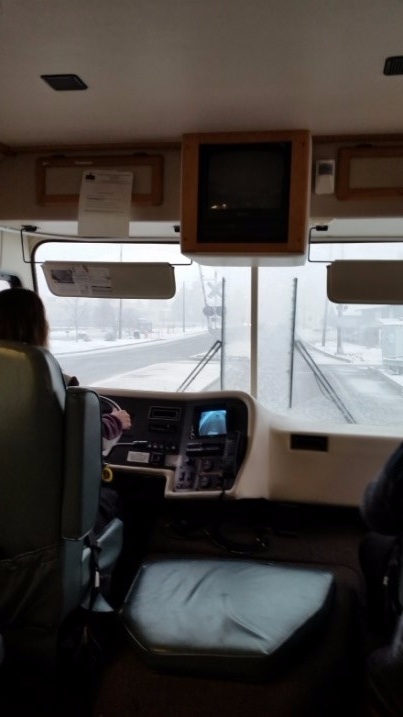Driving in Extreme Weather Conditions
 When it rains or snow comes down, it changes how you drive any vehicle, especially a large one.
When it rains or snow comes down, it changes how you drive any vehicle, especially a large one.
Often times the weather can be fine when you start out but change for the worse once you are on the road. It is the driver’s responsibility to assess the risk of continuing down the road or pulling off the road into a safe place.
The First Thing to Remember: SLOW DOWN IN ADVERSE WEATHER
Large vehicles need to reduce their speed well below posted limits as speed limits are determined by dry roads and daylight hours. Following distance should be increased from 4 seconds to 8 and down shifting can help reduce speed and slow momentum. Stopping distance is increased when traction is decreased. DO NOT use your Engine Brake in poor traction conditions, it can put your vehicle into a spin!
WINTER WEATHER - VISUALIZATION
Snow and ice are the most difficult roadway conditions for a driver. Before starting, mentally go over your route and visualize areas of concern.
- Areas of drifting snow
- Places exposed to wind where black ice could form
- Places where the daylight doesn’t reach to warm an icy spot
- Bridges, over and under passes which could freeze quickly
- Sections where snow could narrow roadway
- Approaches to intersections that have been packed down by other vehicles causing them to be more slippery
- Knowing the route you will take can help you avoid a potentially dangerous situation. .
HEAVY SNOW AND DRIFTING
The more snow, the less friction your tires will have on the road surface and a greater breaking distance is required.
- Keep your windshield, driver’s side window and mirrors clear.
- Ice/frost and condensation will diminish visibility.
- Be sure windshield wipers are in good condition
- When snow begins to pile up, drifts on the roads are common. Never plow through a snow drift, always avoid if possible.
LIMITED VISIBILITY -WHITE OUTS
When blowing snow creates limited visibility, reduce your speed as quickly as you can without locking up your wheels.
- Activate your hazards and use your low–beam headlights and driving lights. High beams reflect off the snow making it harder to see.
- Be patient, avoid changing lanes.
- Keep looking as far ahead as possible. Keep your windows and mirrors clean and use defrosters and wipers to maximize your vision.
BLACK ICE
With Black Ice, look for spots on the roadway which are darker than others or have a shine. Use caution on bridges, under and overpasses.
- Drive slowly to avoid skidding out of control. A slower speed will give you more time to detect and react to the black ice.
- While it may be a natural instinct to slam on your brakes, DON’T. It will only cause your vehicle to lose control.
- Reduce speed gradually by tapping on the brakes lightly and down shifting if necessary.
- Increase your following distance.
HILLS AND GRAVITY
Just because you have traction going up a snow covered hill doesn’t mean you will have it going down.
- Do not power up a hill. Applying power to the wheels on snow covered roads will just start the wheels spinning. Apply power before you start up the hill.
- Try not to stop when travelling up a snow covered hill. Traction will be hard to find and gravity will pull you down to the bottom of the hill.
- As you reach the crest of the hill reduce your speed and proceed down the hill slowly. Downshift before you begin to travel downhill.
SUN GLARE
Glare from the sun can reduce your visibility to near zero.
- Remember sun glare changes from season to season.
- Sunrise and sunset are different in the winter months.
- Visibility can be a problem when the sun is low in the sky and in front of you or reflects off the road or other objects.
- Just because you can see doesn’t mean the other driver can.
- It is crucial to wear sunglasses and use your vehicle’s sun visors.
RAIN
Light or infrequent rain may cause unsafe driving conditions. Visibility can be compromised by heavy rain.
- With rain comes a change in road conditions. At the beginning of a rainstorm, rain water mixes with oil on the road surface making it slick.
- Changes in humidity can cause the windows to fog.
- Water reflecting off oncoming headlights can cause momentary blindness.
SLOW DOWN AND KEEP SAFE!